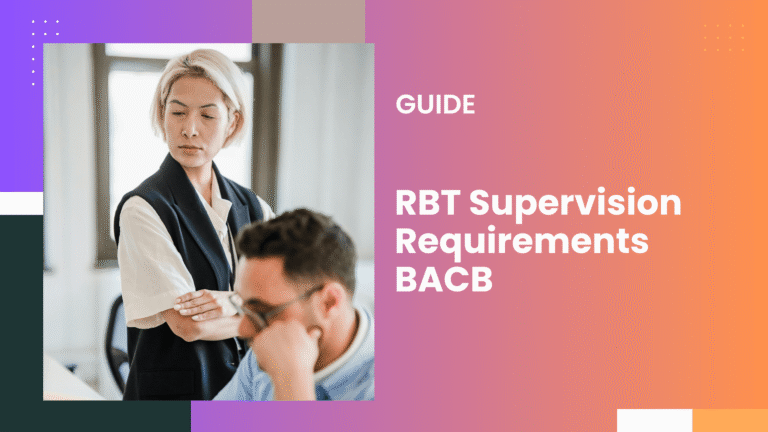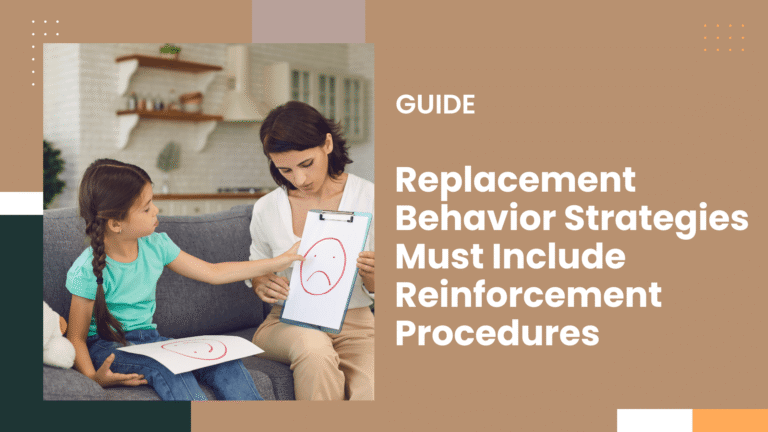BACB RBT Task List TCO 2nd & 3rd Edition | Latest Update

The BACB RBT Task List outlines the core skills and responsibilities of a Registered Behavior Technician, including data collection, teaching, behavior reduction, documentation, and ethics.
It guides training, supervision, and the RBT exam to ensure effective and ethical client support.
| Domain | Tasks | Focus |
|---|
| A. Data & Graphing | A-01–A-08 | Accurate measurement and trends |
| B. Assessment | B-01–B-03 | Understanding client motivation and skills |
| C. Skill Acquisition | C-01–C-11 | Teaching new behaviors effectively |
| D. Behavior Reduction | D-01–D-07 | Reducing unwanted behaviors ethically |
| E. Documentation | E-01–E-04 | Clear, objective reporting |
| F. Ethics | F-01–F-10 | Professional conduct and boundaries |
A. Data Collection & Graphing (8 Tasks)
(A-01 to A-08, ~17% of exam)
A-01: Implement Continuous Measurement
You measure behavior every time it happens, as in frequency (how often), duration (how long), or latency (how quickly it starts).
So, you will be recording each hand-raise during a class session, noting the time so you can calculate the rate.
A-02: Implement discontinuous measurement
Record behavior at intervals (e.g., partial, whole, momentary time sampling).
Example: You check if the client is on-task every 30 seconds for 10 minutes.
A-03: Implement permanent product recording
Measure the outcome, not the behavior itself, such as counting completed worksheets after a session.
A-04: Enter data and update graphs
You input data into a system or chart and visually track progress. Let’s say, graphing the weekly frequency of independent mands.
A-05: Describe behavior/environment in objective terms
Use observable and measurable language—no opinions.
So, instead of “angry outburst,” you will write “screamed for 5 seconds and slammed the desk.”
A-06: Calculate and summarize data
You convert data into meaningful stats—rates, percentages, averages.
Example: 8 mands in 20 minutes = 0.4 per minute (rate).
A-07: Identify trends in graphed data
You read the chart and know if behavior is increasing, decreasing, or flat.
Example: Noticing a downward trend in tantrums over two weeks.
A-08: Describe the risks of unreliable data or poor fidelity
You know what happens if the data is wrong or you skip the plan steps.
So, if you miss recording each prompt, you won’t know if your fading plan worked.
B. Behavior Assessment (3 Tasks)
(B-01 to B-03, ~11% of exam)
B-01: Conduct preference assessments
You determine what motivates the client and multiple stimulus, paired, and free operant.
Let’s take an example, you offer several toys and record which the client picks consistently.
B-02: Participate in skill assessments
You gather data on a client’s current abilities such as social, developmental, and academic. During a curriculum-based check, you note how many math problems the client completes correctly.
B-03: Participate in functional assessments
You help collect data that identifies why behaviors occur. e.g., ABC data collection. You record what happens before, during, and after a tantrum to find its function.
C. Behavior Acquisition (11 Tasks)
(C-01 to C-11, ~25% of exam)
C-01: Implement reinforcement procedures
Deliver reinforcement correctly and timely, contingent, and matched to needs.
Example: You immediately give praise and a sticker after a correct response.
C-02: Use conditioned reinforcers
Pair a neutral item with a reinforcer so it becomes motivating.
Example: Pairing a token board with candy results in tokens becoming rewarding.
C-03: Implement discrete‑trial teaching (DTT)
You teach skills using structured trials with prompts and reinforcers.
Example: Present an SD (“Touch nose”), prompt if needed, and reinforce correct response.
C-04: Implement naturalistic teaching (NET)
You teach in real-life situations using client interests.
Example: If the child wants bubbles, you use that opportunity to teach communication.
C-05: Implement chaining
Teach step-by-step sequences—forward, backward, or total task.
Example: Teaching toothbrushing by breaking down each step and prompting sequentially.
C-06: Implement discrimination training
Teach clients to distinguish between similar items or commands.
Example: Show “red” and “blue” cards and reinforce correct labeling.
C-07: Use prompting and fading
Help client respond and gradually reduce help to support independence.
Example: Start with physical guidance, then shift to a gesture, then silent prompt.
C-08: Implement generalization procedures
Make sure skills work across people, settings, and materials.
Example: After a child learns to request snacks with you, you ask mom to practice the same routine.
C-09: Distinguish maintenance vs acquisition
Know when a skill is learned vs needs ongoing practice.
Example: Once a skill is at 90% success across sessions, the goal shifts to maintenance.
C-10: Implement shaping procedures
Reinforce successive approximations toward the target behavior.
Example: Reward saying “ba,” then “ball,” until the full word is achieved.
C-11: Implement token economies
Use tokens as conditioned reinforcers exchanged later for items or privileges.
Example: Each correct response earns a token; 5 tokens = 5 minutes of iPad time.
D. Behavior Reduction (7 Tasks)
(D-01 to D-07, ~19% of exam)
D-01: Identify common behavior functions
Understand whether behavior serves attention, escape, tangible, or sensory.
Example: You note tantrums happen when demands are placed—likely escape function.
D-02: Implement antecedent interventions
Change what happens before behavior to prevent it—e.g., non-contingent reinforcement.
Example: Give free access to preferred items before a known trigger, like cleanup time.
D-03: Implement differential reinforcement
Reinforce alternative, incompatible, or low rates of behavior.
Example: Use DRA by reinforcing the child for asking instead of hitting.
D-04: Implement extinction procedures
Stop reinforcing the problem behavior as outlined in the plan.
Example: If a tantrum aims to escape demands, you continue the demands and ignore the tantrum (with safety).
D-05: Implement positive/negative punishment
Apply time-out or response cost only as in the behavior plan.
Example: Remove tokens after unsafe behavior, following BCBA instructions.
D-06: Describe the side effects of extinction/punishment
Understand phenomena like bursts, emotional responses, or resurgence.
Example: Recognizing tantrums might peak after extinction is begun.
D-07: Follow crisis/emergency procedures
Execute protocols like safety holds when risk arises.
Example: Use agreed-upon blocking if a client becomes physically aggressive.
E. Documentation & Reporting (4 Tasks)
(E-01 to E-04, ~13% of exam)
E-01: Communicate with supervisor regularly
Check in with your BCBA about data trends or session issues.
Example: You email your BCBA halfway through the week about inconsistent progress.
E-02: Seek clinical direction when needed
Promptly ask for help if something’s unclear or the data seems off.
Example: Client begins self-injury; you immediately request supervisor support.
E-03: Report client-impacting variables
Tell your team about changes—medications, sleep, illness.
Example: You note the child had no breakfast, which may explain behavior differences.
E-04: Write objective session notes
Document facts only—what happened and when.
Example: “Client completed 8/10 mands independently, required 2 full prompts.”
F. Ethics (10 Tasks)
(F-01 to F-10, ~15% of exam)
F-01: Follow supervision rules
Know how much oversight you require and who qualifies as a supervisor.
Example: You meet weekly with BCBA and log hours per BACB rules.
F-02: Apply ethical principles
Respect confidentiality, integrity, and professional responsibility.
Example: You store session data securely, never share it on social media.
F-03: Follow gift policies
Know when gifts are okay and when they cross a boundary.
Example: Decline expensive birthday gifts, but accept a thank-you card.
F-04: Maintain professional boundaries
Don’t become friends with clients or make personal arrangements.
Example: You don’t add clients on personal social media or enter their homes outside work.
F-05: Respect client dignity
Treat clients with compassion and avoid demeaning responses.
Example: You use person-first language and avoid making clients feel ashamed.
F-06: Practice cultural humility
Acknowledge and adapt to the client’s background and values.
Example: You ask parents about holiday schedules before planning sessions.
F-07: Avoid unethical punishment
Never improvise punishment procedures.
Example: You follow time-out rules only when outlined by your BCBA.
F-08: Accept feedback gracefully
Learn from feedback and document your improvement.
Example: Supervisor points out delayed praise—next session, you adjust timing.
F-09: Communicate only with approved stakeholders
Share information only with authorized people.
Example: You don’t discuss client progress with anyone outside the care team.
F-10: Know the harm of poor data/fidelity
Understand that unreliable data harms client care and ethics.
Example: You double-check data entry to ensure treatment decisions are valid.
Is There a New RBT Task List?
Yes, there’s a new version of the task list, and it’s called the RBT Test Content Outline (3rd Edition).
So, my advice would be that if you were trained with the older 2nd edition, don’t panic because most of it still applies.
But a few things are different, and if you’re prepping for the exam now or getting supervised, you’ll want to know what’s changed.
What Changed from RBT 2nd Edition?
1. The Name Changed
The BACB has renamed the “Task List” to “Test Content Outline” (TCO). But don’t you worry, as it still covers the same purpose: the core skills every RBT needs to learn, use, and be tested on.
They just made it sound more official.
2. More Tasks Added
- The old version had 37 tasks.
- The new one has 43 tasks.
That means you will need to be aware of 6 more tasks; they have removed a few, and cleaned up the language to make things clearer and specific.
3. New Things You’ll Need to Know
The 3rd edition focuses a little more on the following:
- Data analysis – You’ll need to know how to read graphs and explain what the data means.
- Ethics – Expected to follow clearer rules about gifts, respect, boundaries, and cultural sensitivity.
- Punishment procedures – You must learn how they work and what side effects to expect (like extinction bursts).
- Real-world behavior – The language now matches what you actually do during sessions.
4. Some Tasks Were Removed or Rewritten
A few of the tasks got taken out, such as “preparing for data collection.” I think this is because they overlapped with other areas.
Others got split up or updated with clearer language.
Example: Basically, in the 2nd edition, you just had one general task on reinforcement. In the new one, it’s broken down into different types of reinforcement and when to use them.
5. Exam Changes
If you are curious about the exam format, it hasn’t changed much:
- You’ll still answer 85 questions (75 scored + 10 trial questions).
- What’s different is how many questions come from each section.
Now, i want you to focus more on:
- Data collection
- Behavior reduction
- Ethics
Skill teaching (which used to have more questions) is still important, but now it’s a little lighter on the exam.
When does the New RBT Test Content Outline take effect?
The 3rd Edition RBT Test Content Outline will go into effect on January 1, 2026.
Do I need to study different materials if I’m testing before 2026?
No, for those who are taking the RBT exam before January 1, 2026, you should study the 2nd Edition RBT Task List. After that date, you’ll need to prepare using the 3rd Edition Test Content Outline.
I really hope I cleared up a few of your doubts about the task list or the TCO. But if you still need help, you can always contact me via our contact us page or comment down below, and I will try to get back to you as soon as possible.






